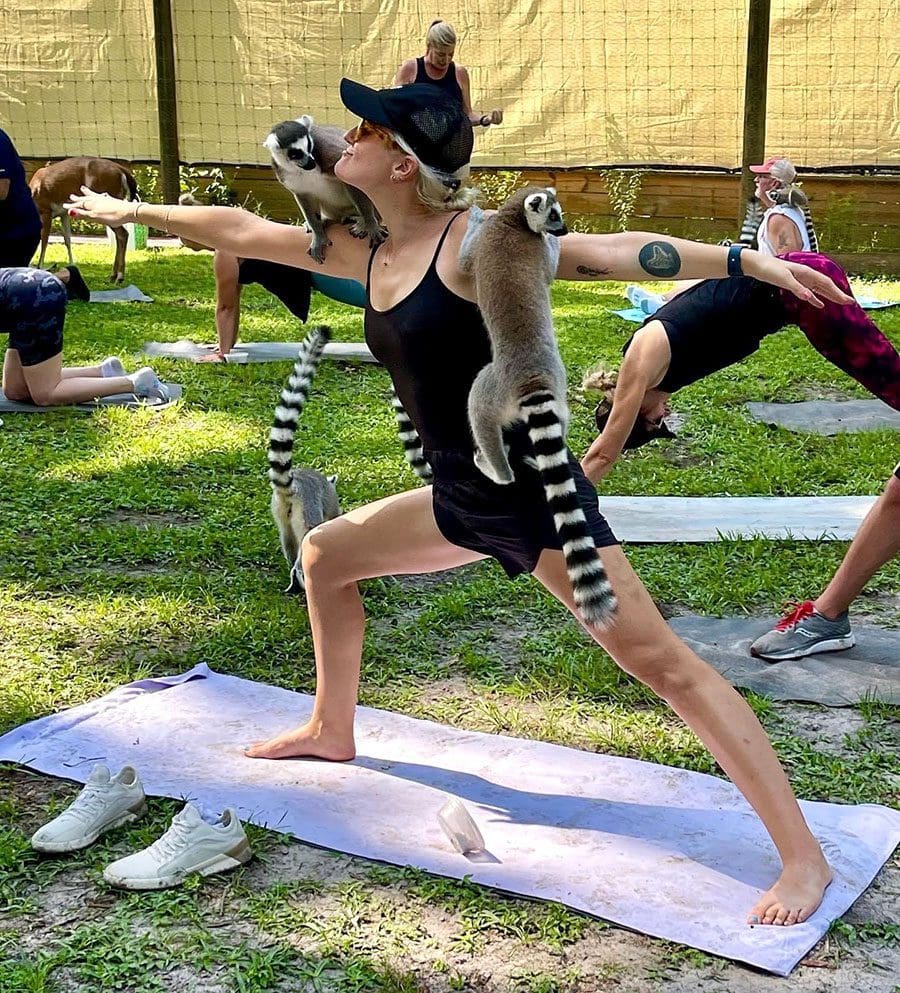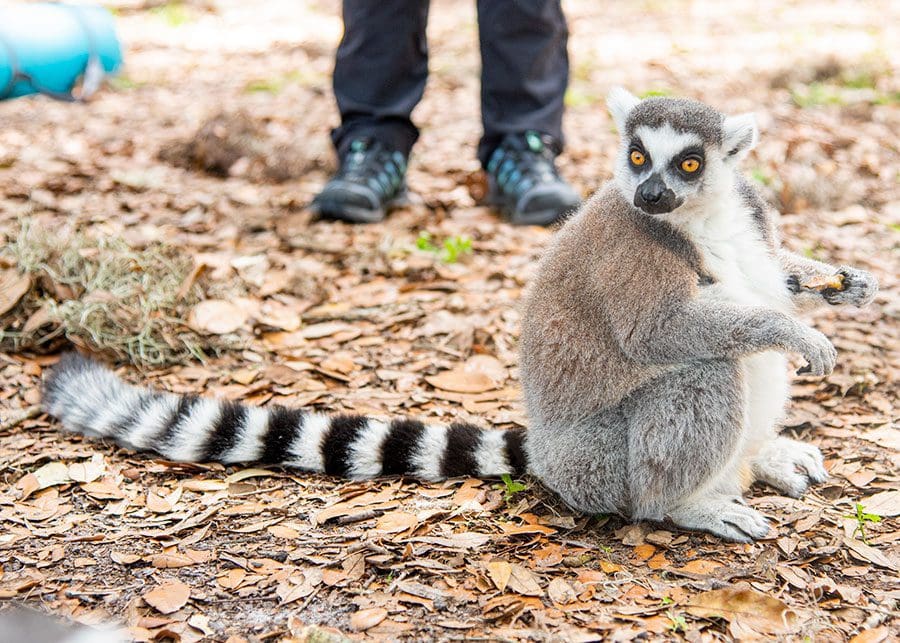
By Roxanne Brown
Yogatta be kidding me

At Chase Animal Rescue Sanctuary, having a lemur as a yoga companion is hardly a stretch.
Photos taken by Nicole Hamel.
Yoga class photos provided by Chase Animal Rescue and Sanctuary.
Irene Tsatiris truly enjoys the benefits of yoga and has been taking classes for years.
Still, she never had reason to imagine herself in a butterfly, swan or child’s pose with a lemur doing the perfect balancing act on her back, climbing along her outstretched arms or legs, sitting on her shoulders, or using her head to catapult itself into a nearby oak tree, that is, until last year when she heard it was actually a thing.
“One of my yoga instructors just casually said, ‘Oh my gosh, I have to go teach my lemur yoga class now,’ and I was like, ‘I’m sorry, what?’” Irene recalls, adding that when her teacher told her more about it, her response was: “I must do this!”
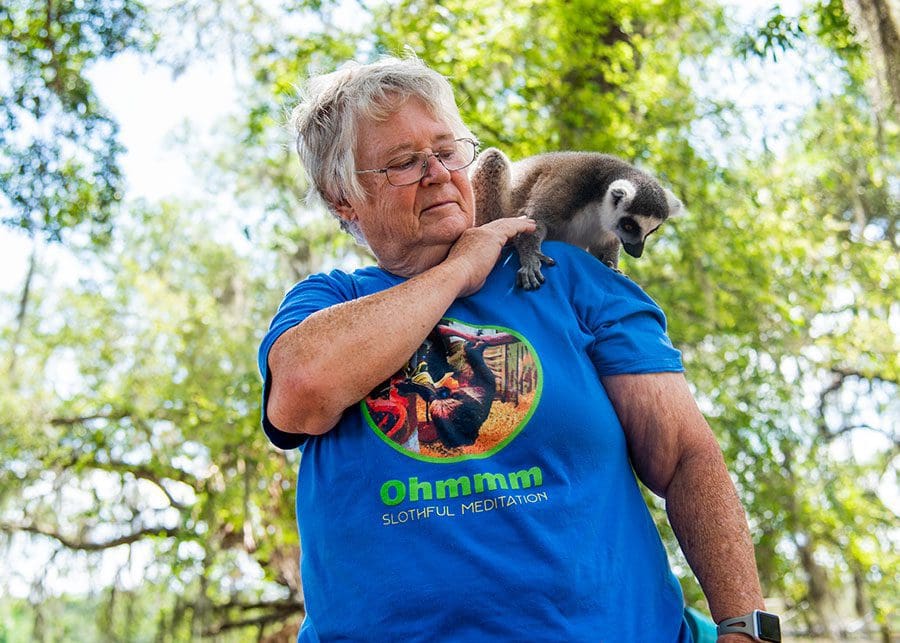
Kim Schaub
The class Irene attends periodically is offered at 10 a.m. every Saturday at the Chase Animal Rescue Sanctuary, a not-for-profit animal rescue facility and safe haven in Webster for critically endangered primates, and other rare and exotic rescues in need of care
and rehabilitation.

Nina Vassallo
Owners Nina and Donna Vassallo, who started Chase Rescue 14 years ago, say the facility runs solely on donations. Because donations are sometimes hard to come by, however, they began offering private tours and various types of classes involving unique animal encounters, including Lemur Yoga.
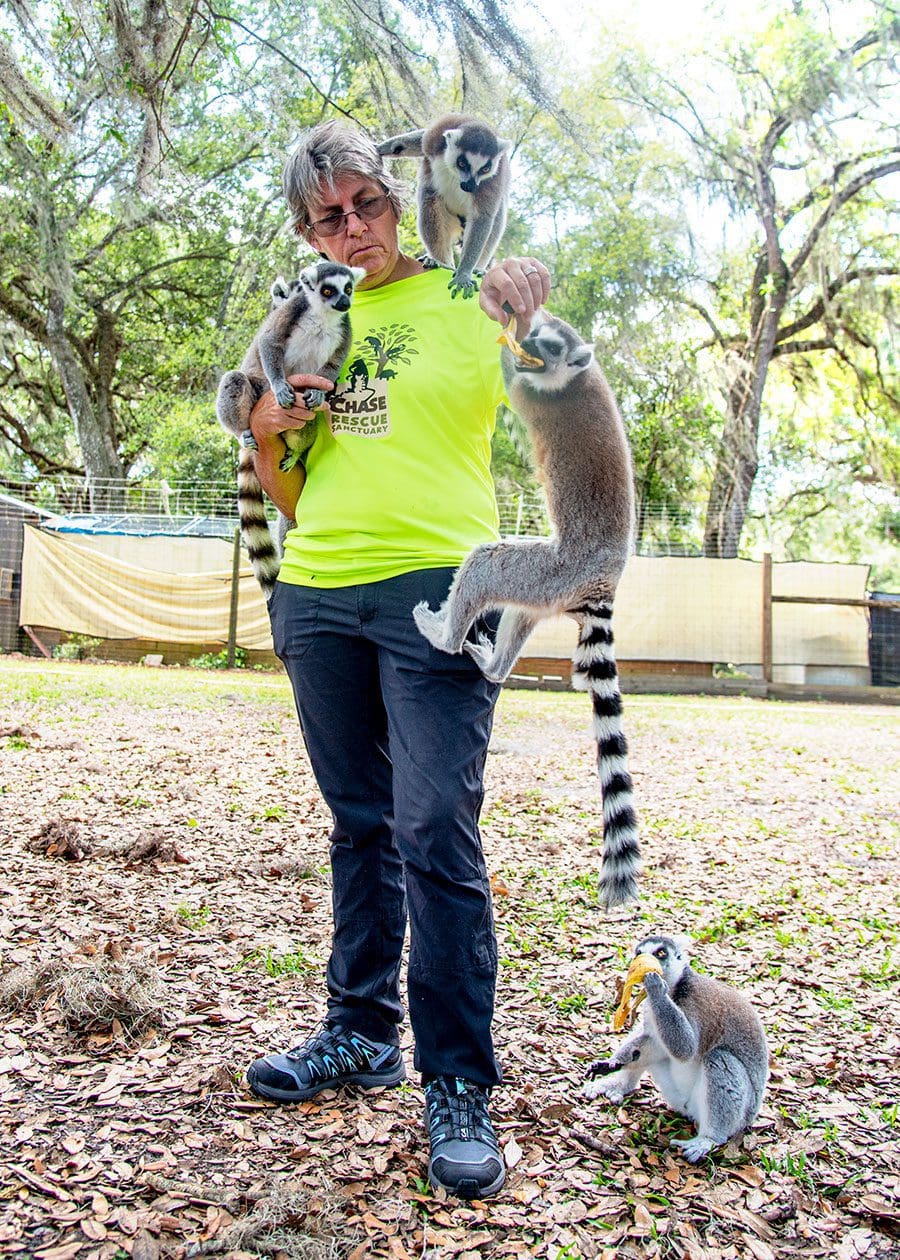
Donna Vassallo
The class fees are used solely for operating expenses, and although the classes are intended to promote health and wellness, they are also utilized as a platform for raising awareness about the critically endangered state of ruffed lemurs and cotton-top tamarins, the illegal capture and pet trading of exotic animals, deforestation, slash and burn agriculture, etc., and what people can do to help.
At the same time, Nina says the classes benefit humans in more ways than one.
“We set up under the oak trees, out in nature, so that the lemurs will come eat, and so they can climb up in the trees and play, and it’s really a serene experience for everyone,” Nina says.
Irene appreciates the serenity, and says she’s really gotten a lot out of the class.
“When I came here and experienced it for the first time, a curious little lemur touched my hand, and it felt so soft and sweet. It was like connecting with nature in a way that was so different than going to a zoo and seeing an animal from afar,” Irene says. “Interacting with lemurs is incredible, it feels magical and I never get tired of it, and that’s how I feel about practicing yoga too, so the classes here are a good mix.”
Penny Dittbrenner, a longtime certified yoga instructor who teaches at Chase, says the benefits of yoga, which include breathing, stretching and quieting of the mind, are enhanced by the addition of lemurs because they induce happiness.
Penny says in turn, happiness, like eating right and exercising, has its own positive health benefits, too.
“In addition to the benefits of yoga in general, I think that practicing with the lemurs adds an element of joy and wonder and nobody has a bad class,” Penny says, explaining that the classes she teaches are good for beginners or more advanced students alike, and that students can choose to participate in every pose or sit out at any time to interact with or feed the animals.
Nina says the animals are never forced to participate either and they can roam freely from mat-to-mat mimicking poses, look for food from students provided by the sanctuary, run around and play, or return to their habitat.
“Even if you don’t do the yoga, those lemurs just bring so much joy to everybody. The smiles are radiant and everybody just has such a good time,” Penny adds. “It’s really relaxing as well, because when you’re that happy, your body and your mind are naturally relaxed.”
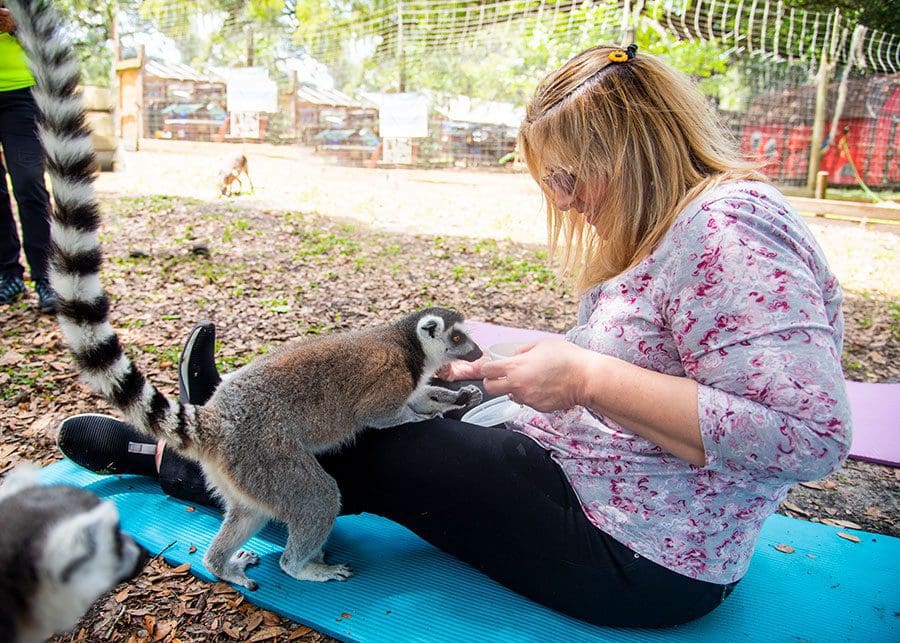
Julie Hanson, a 40-year fitness instructor, with eight years under her belt as a yoga instructor, also teaches at the rescue.
Julie says she sees yoga as a very healthy practice that benefits people by improving their posture, balance, strength, breath, relaxation and movement, plus it’s a practice that brings spirituality into people’s lives.
Julie says practicing yoga outside among nature, and with the lemurs, takes the experience to a whole other level. She also says before she started teaching at Chase, she’d heard of goat, cat, alpaca and even dog yoga, but never yoga with lemurs.
Regardless, Julie says she’s noticed that every student leaves her class with more bounce in their step than when they arrived.
“Nobody knows each other, everyone’s at their own level of yoga, but the lemurs bond the class together,” Julie says. “The lemurs add so much to the experience and there’s nothing like it, unless you go to Madagascar or something. You’ll go home and talk for hours about your experience with these cute, curious, soft, funny little animals.”
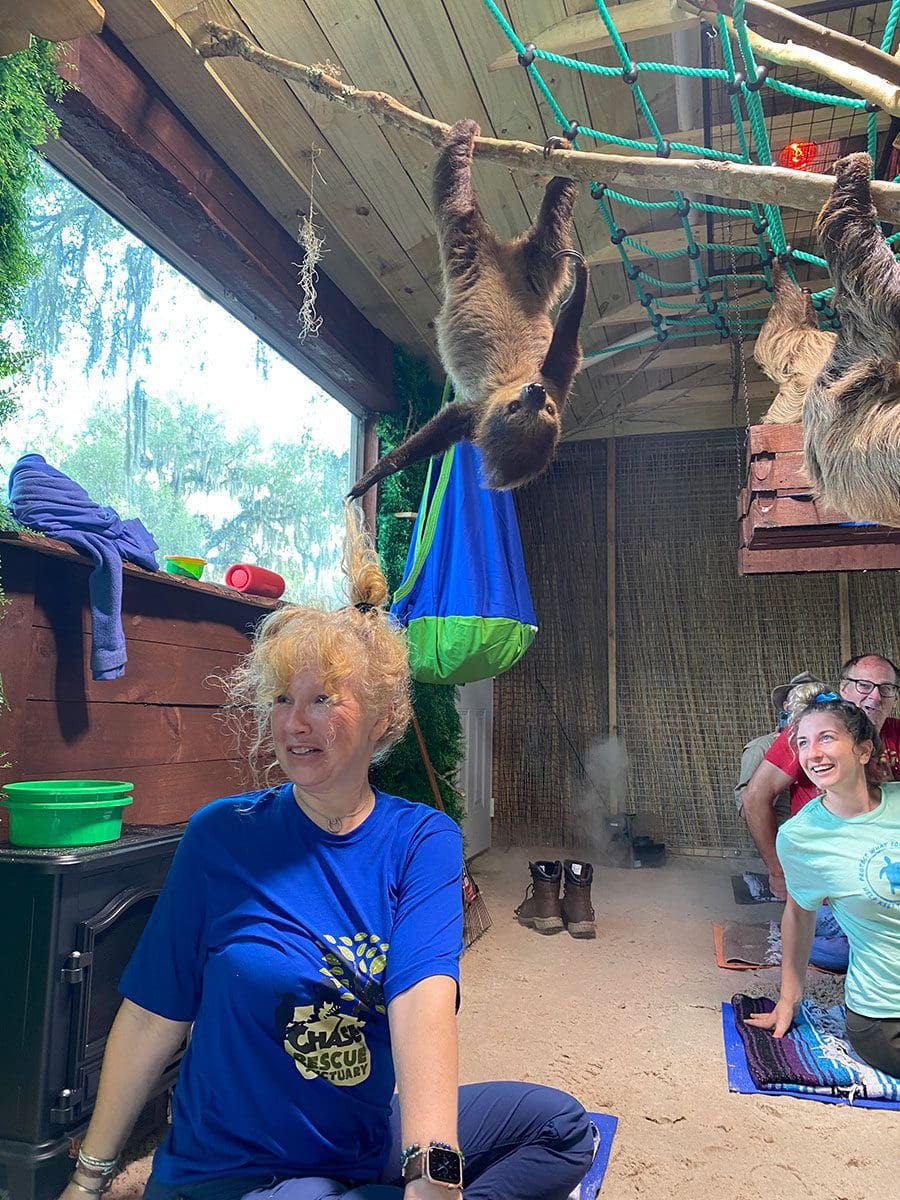
But there’s more.
After realizing how popular the Lemur Yoga classes have remained week after week for the past two years since having introduced them, Nina and Donna put their heads together and came up with other options to benefit residents and guests alike.
Other classes/events Chase Rescue now offers include Painting with Primates, a class that allows students to sit outside in nature, and paint on a canvas, while a docile family of Ruffed Lemurs plays all around them, and if lucky, add paw prints to their masterpieces, and Acoustics in the Afternoons, a gathering where people join the lemurs outside under the the grandfather oaks at the facility for a laid back concert put on by local musicians.
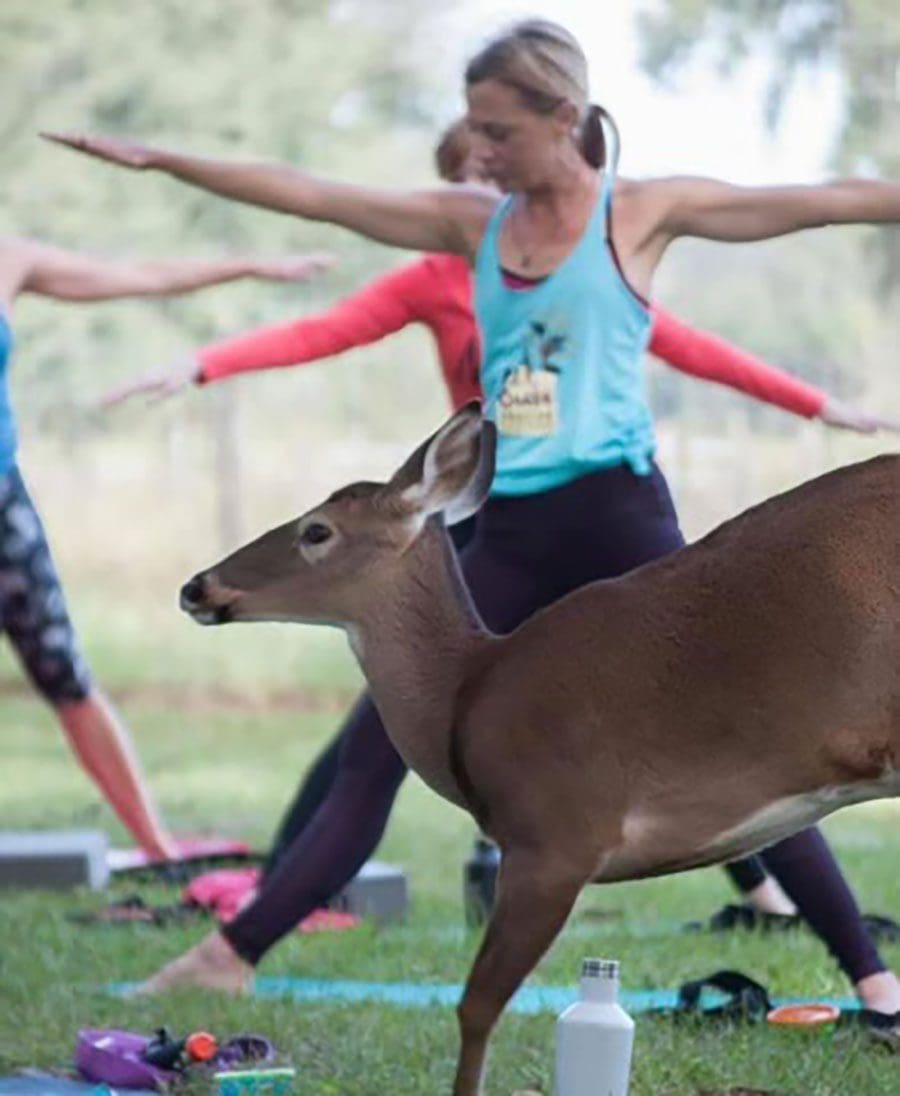
People can also book private tours, which include an inside look at the entire 10-acre Chase facility, its mission, and a chance to see the approximate 160 animals who live there, including anteaters, kangaroos, deer, Patagonian cavy, ruffed lemurs, cotton top tamarins, exotic birds, tortoises, potbellied pigs and more.
Last but not least, Sloth Meditation, a class that just started in March, has quickly become wildly popular.
The one-hour classes, offered twice a month on Saturday mornings, are held inside the sloth enclosure built specifically to simulate their natural habitat, right down to the tropical temperatures required by Chase’s two resident sloths: Seymour and Sang Mu, both rescues brought to the facility when the people who had them as pets could no longer care for them.
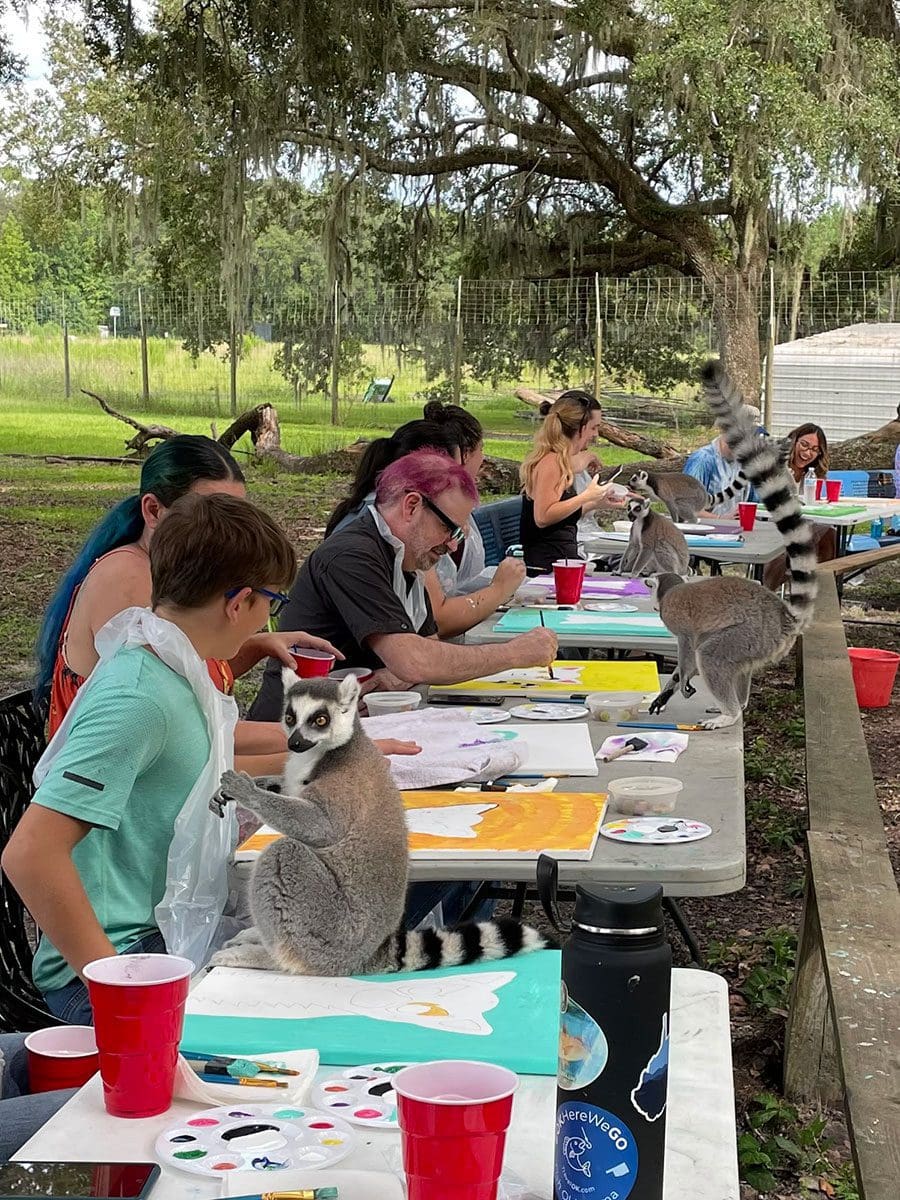
Penny leads the classes and according to Nina, makes you feel like you are a sloth slowly moving about in their world; a beneficial visualization since sloths are one of the quietest, most passive, peaceful animals of all.
Penny describes the sloth meditation class as soothing and although students are not permitted to touch or take selfies with the sloths, they are able to witness the animals up close and personal as they learn to be one with them.
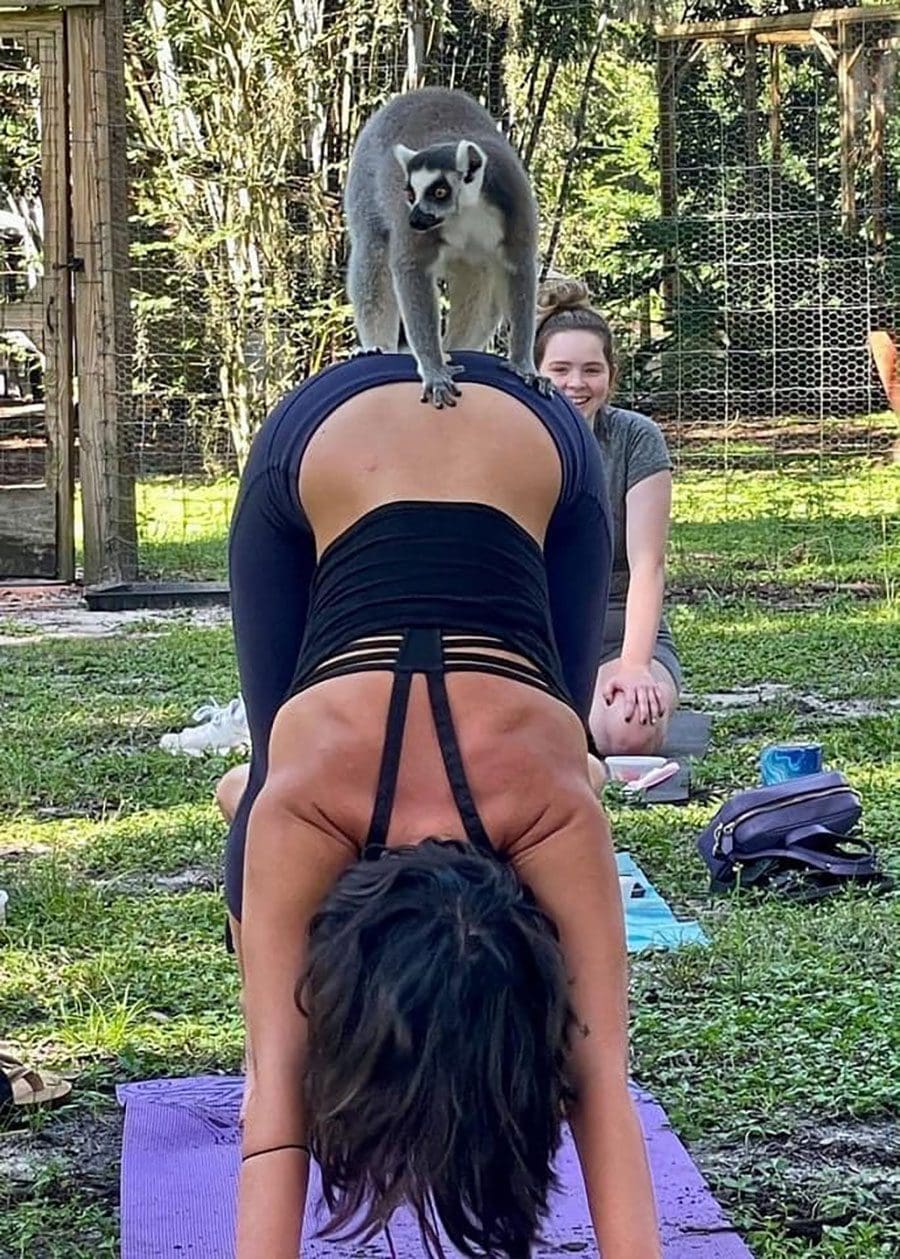
“Students lay down on their mats in this beautiful environment with the sloths doing their own thing around them, and I lead them through what’s called a Nidra meditation, also known as sleep yoga, but it’s a 30-35-minute-long meditation,” Penny says.
Penny says comments she frequently hears from students after her class, is that they have never felt so relaxed or peaceful, and that they loved embracing their inner sloth.
“It’s a really nice experience and it’s extremely relaxing. In fact, 30 minutes of a Nidra meditation is equal to three hours of deep restorative sleep,” Penny says, explaining that what she does first, is calm the entire physical person, starting with relaxing every part of their bodies, then working her way into relaxing their breathing, then their emotional and mental states.
“We relax all the layers of the body, so you get to that place of, I’ll call it bliss, for lack of a better term, where you can totally relax fully,” Penny says. “Then I give them a visualization as if they are a sloth in the rainforest, in a tree, just waking up, moving from branch to branch, and spotting a glistening rain-drenched leaf, and so on, while encouraging them to close their eyes and take nice deep breaths.”
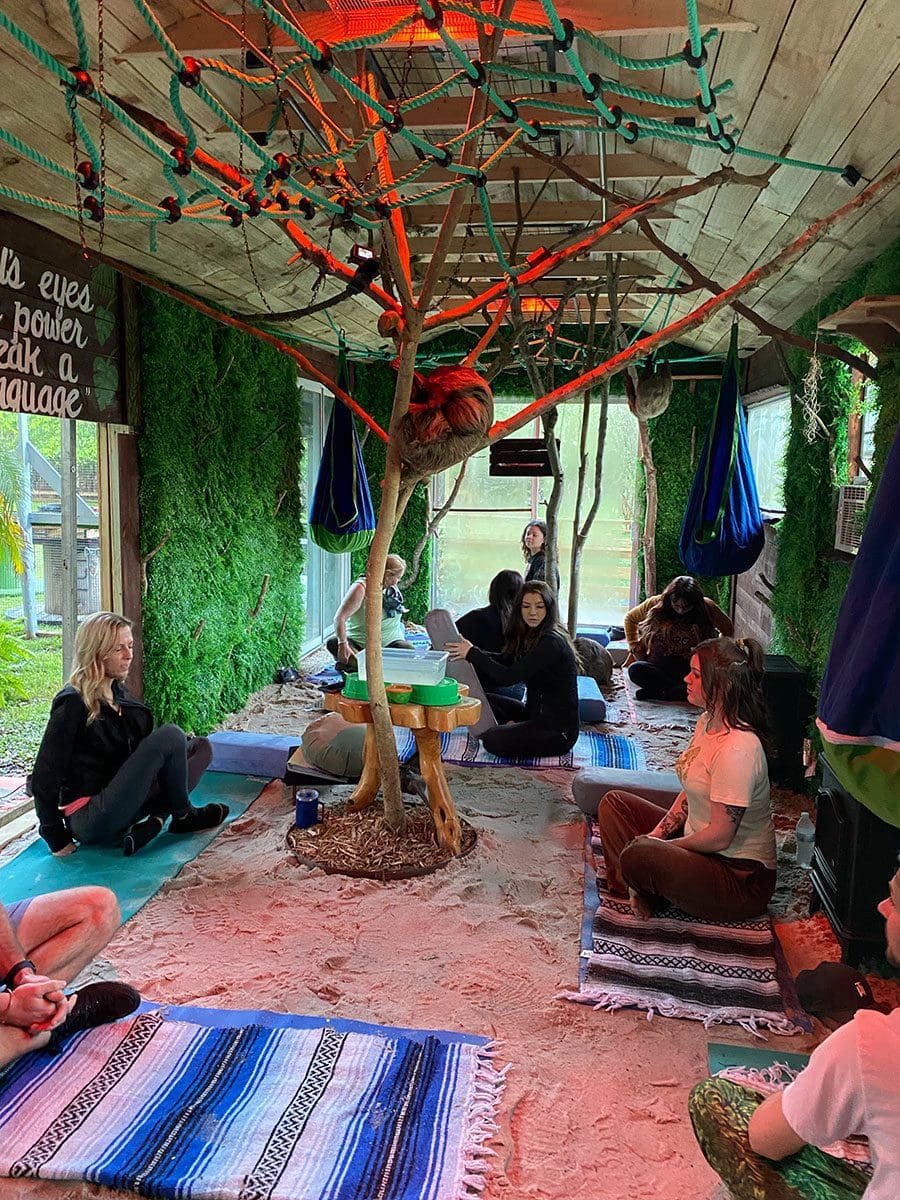
Penny says after she completes their visualizations, and guides students back into their human body and to a fully awake state, they tend to feel refreshed and new.
“People say they love it and that it’s just wonderful. I have some tell me that they fell asleep half way through it, or were in and out of a sleep state, which is very common,” Penny says. “I had a woman tell me she hadn’t relaxed that deeply in like six years.”
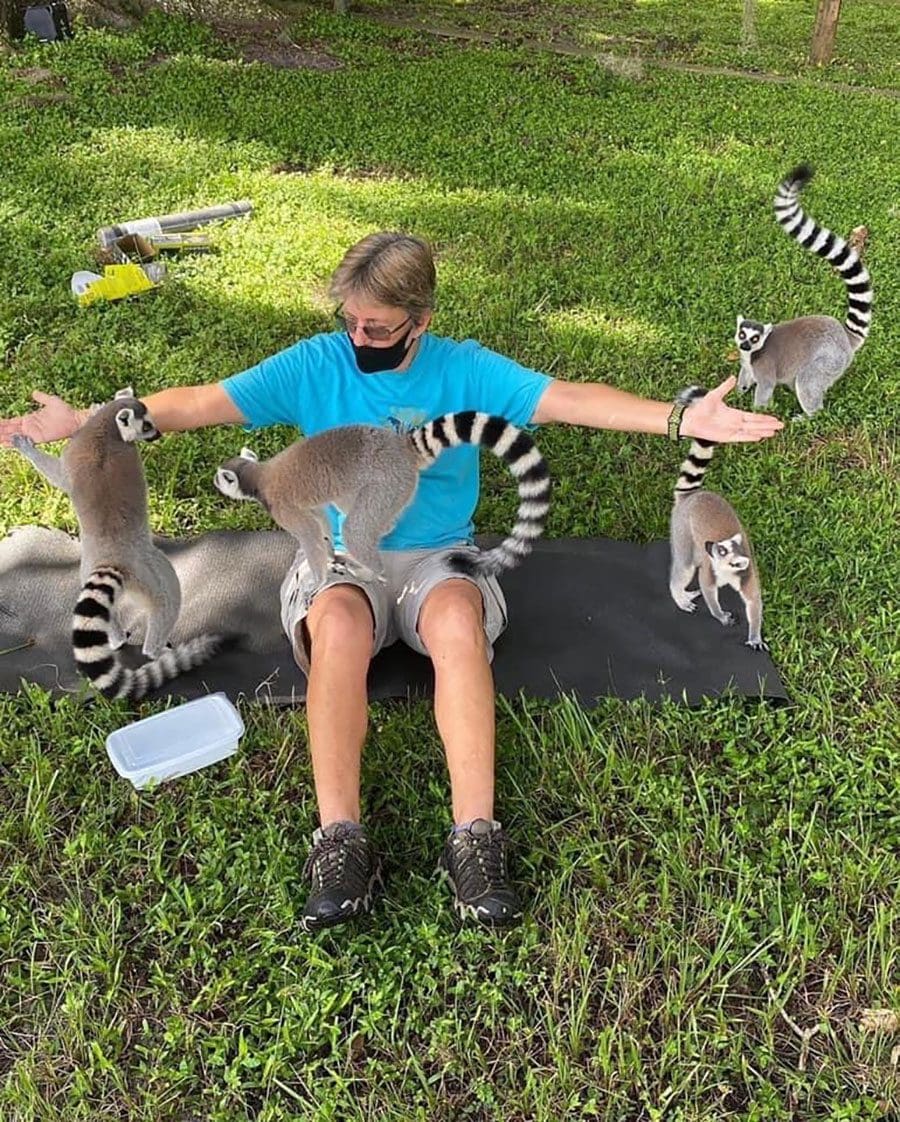
Penny says she encourages people, even if they’ve never done it, to try yoga or the Nidra meditation because the benefits of both are great, especially with the fun element of animal encounters that go along with them at Chase Rescue.
“These are two of my favorite classes I teach because I get to see the joy on people’s faces and their smiles when at the sanctuary,” Penny says. “Also, I love that Nina and Donna try to keep everything they do out there Zen and beneficial for the animals as well as for guests.”
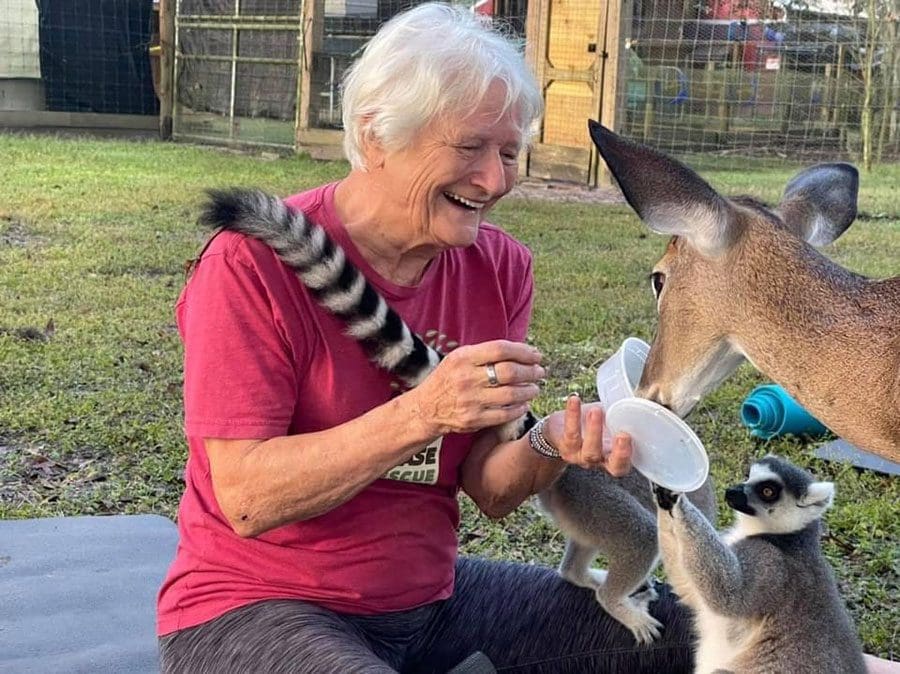
Nina says Chase Animal Rescue abides by what’s known as the WAZA guidelines for responsible and ethical animal/visitor interactions no matter the experience.
For details about those guidelines, for more information about the rescue
and the classes, or to donate, call 352.988.8014, visit chasesanctuary.org or follow them on Facebook by visiting
@ChaseRescueSanctuary.
Originally from Nogales, Arizona, Roxanne worked in the customer service industry while writing independently for years. After moving to Florida in 1999, Roxanne eventually switched her career path to focus more on writing and went on to become an award-winning reporter for The Daily Commercial/South Lake Press newspapers for 16 years prior to coming on board with Akers Media as a staff writer in July 2020 – her dream job come true.


